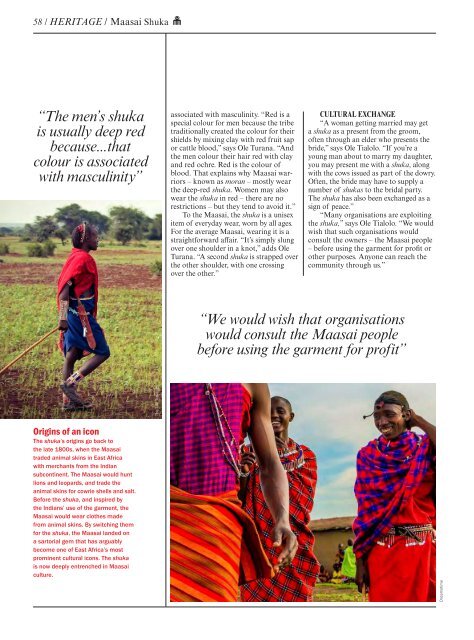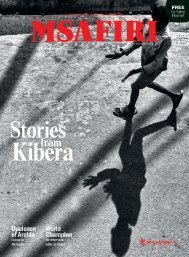You also want an ePaper? Increase the reach of your titles
YUMPU automatically turns print PDFs into web optimized ePapers that Google loves.
58 / HERITAGE / Maasai Shuka<br />
HERITAGE / 59<br />
“The men’s shuka<br />
is usually deep red<br />
because...that<br />
colour is associated<br />
with masculinity”<br />
associated with masculinity. “Red is a<br />
special colour for men because the tribe<br />
traditionally created the colour for their<br />
shields by mixing clay with red fruit sap<br />
or cattle blood,” says Ole Turana. “And<br />
the men colour their hair red with clay<br />
and red ochre. Red is the colour of<br />
blood. That explains why Maasai warriors<br />
– known as moran – mostly wear<br />
the deep-red shuka. Women may also<br />
wear the shuka in red – there are no<br />
restrictions – but they tend to avoid it.”<br />
To the Maasai, the shuka is a unisex<br />
item of everyday wear, worn by all ages.<br />
For the average Maasai, wearing it is a<br />
straightforward affair. “It’s simply slung<br />
over one shoulder in a knot,” adds Ole<br />
Turana. “A second shuka is strapped over<br />
the other shoulder, with one crossing<br />
over the other.”<br />
CULTURAL EXCHANGE<br />
“A woman getting married may get<br />
a shuka as a present from the groom,<br />
often through an elder who presents the<br />
bride,” says Ole Tialolo. “If you’re a<br />
young man about to marry my daughter,<br />
you may present me with a shuka, along<br />
with the cows issued as part of the dowry.<br />
Often, the bride may have to supply a<br />
number of shukas to the bridal party.<br />
The shuka has also been exchanged as a<br />
sign of peace.”<br />
“Many organisations are exploiting<br />
the shuka,” says Ole Tialolo. “We would<br />
wish that such organisations would<br />
consult the owners – the Maasai people<br />
– before using the garment for profit or<br />
other purposes. Anyone can reach the<br />
community through us.”<br />
“We would wish that organisations<br />
would consult the Maasai people<br />
before using the garment for profit”<br />
The Life Traveller<br />
Origins of an icon<br />
The shuka’s origins go back to<br />
the late 1800s, when the Maasai<br />
traded animal skins in East Africa<br />
with merchants from the Indian<br />
subcontinent. The Maasai would hunt<br />
lions and leopards, and trade the<br />
animal skins for cowrie shells and salt.<br />
Before the shuka, and inspired by<br />
the Indians’ use of the garment, the<br />
Maasai would wear clothes made<br />
from animal skins. By switching them<br />
for the shuka, the Maasai landed on<br />
a sartorial gem that has arguably<br />
become one of East Africa’s most<br />
prominent cultural icons. The shuka<br />
is now deeply entrenched in Maasai<br />
culture.<br />
Dreamstime<br />
Mirjam Bleeker
















